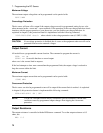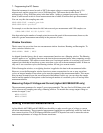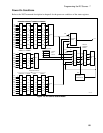
7 - Programming the DC Source
78
Pulse Measurements
After pulse data has been acquired, use FETCh queries to return measurement data in the shortest time.
FETCh queries do not trigger the acquisition of new measurement data, but return different calculations
from the data that was acquired. If you acquired voltage data, you can fetch only voltage measurements;
if you acquired current data you can fetch only current measurements, otherwise an error will occur.
The dc source has several measurement queries that return key parameters of pulse waveforms as shown
in Figure 7-3.
FETC:CURR:LOW?
FETC:VOLT:LOW?
FETC:CURR:MIN?
FETC:VOLT:MIN?
FETC:CURR:HIGH?
FETC:VOLT:HIGH?
FETC:CURR:MAX?
FETC:VOLT:MAX?
DATA POINTS
Figure 7-3. Measurement Commands Used to Return Pulse Data
Minimum and Maximum Measurements
To return the maximum or minimum value of a pulse or ac waveform use:
FETC:VOLT:MAX? or
FETC:VOLT:MIN?
FETC:CURR:MAX? or
FETC:CURR:MIN?
High/Low Measurements
The value of the high level or low level of a pulse can also be measured. High and low level
measurements are defined as follows: The instrument first measures the minimum and maximum data
points of the pulse waveform. It then generates a histogram of the pulse waveform using 16 bins between
the maximum and minimum data points. The bin containing the most data points above the 50% point is
the high bin. The bin containing the most data points below the 50% point is the low bin. The average of
all the data points in the high bin is returned as the High level. The average of all the data points in the
low bin is returned as the Low level. If no high or low bin contains more than 1.25% of the total number
of acquired points, then the maximum or minimum value is returned by these queries.
To return the average value of the high bin, use:
FETC:CURR:HIGH? or
FETC:VOLT:HIGH?
To return the average value of the low bin, use:
FETC:CURR:LOW? or
FETC:VOLT:LOW?


















